Driver’s view: Steve Bushell rates his New Holland CH7.70 combine
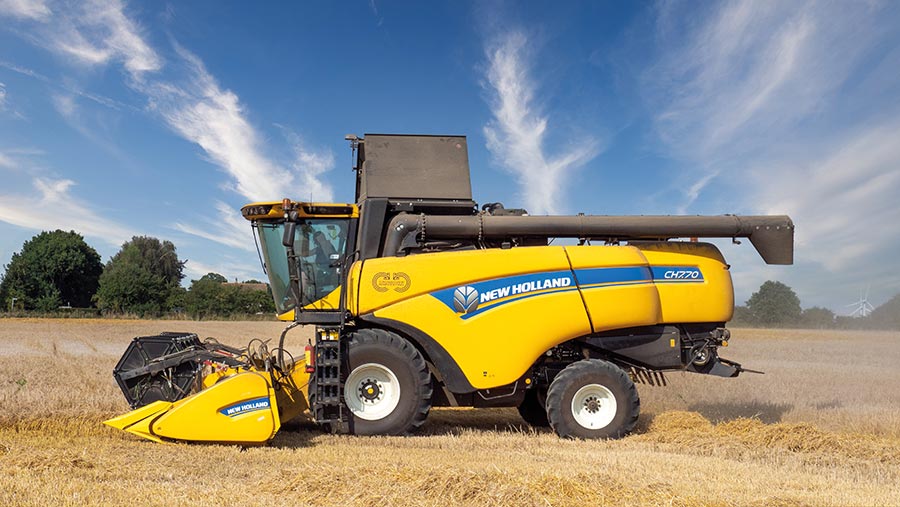 The first production machine to land on UK shores, Steve Bushell’s CH7.70 © James de Havilland
The first production machine to land on UK shores, Steve Bushell’s CH7.70 © James de Havilland For years the big debate between combine owners, operators and engineers came down on one of two sides – straw walkers or rotors.
But by the 1990s the water had muddied with the arrival of various “hybrid” machines, combining both a threshing drum and pairs of separation rotors. Claas’ Lexion 480 kicked things off, then John Deere’s CTS and, more recently, Agco’s MF Delta models.
See also: Ultimate guide to buying a combine 2022
These weren’t the first to pair conventional threshing with rotary separation.
Back in the 1980s, New Holland had also dabbled with its own take on the crossbred combine.
Its “Twin-Flow” TF models used a traditional TX-style drum and concave up front, followed by a large-diameter transversely mounted rotor that split the stream of straw and knocked any residual grain out of it.
The concept worked well, and for anyone looking for a truly high-capacity combine at the time it provided a lot of the answers.
However it was hard on the straw, earning a reputation with baling contractors as a machine to avoid following.
Quietly, the TF held its own for a couple of decades but, as demand for greater output grew, it struggled to keep up – its design proving difficult to modify to generate more capacity, no matter how much extra horsepower was thrown at it.
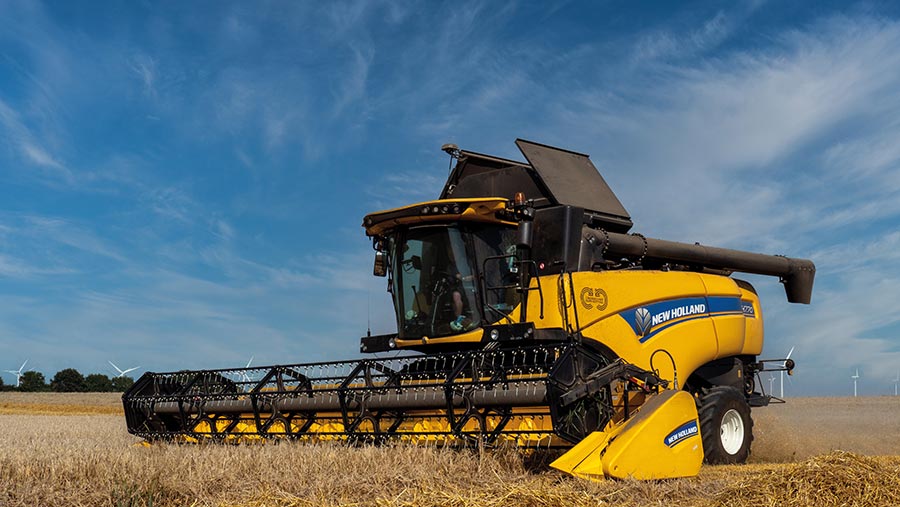
© James de Havilland
New Holland decided a different approach was needed and, having had success with its pure twin-rotor TRs, the company decided to shelve the TF.
In the early 2000s two clear lines of yellow-painted combines emerged – CX-badged straw-walkers and twin-rotor CRs, effectively Belgian-built versions of the company’s US-made flagship (albeit modified for European conditions).
Alongside these were smaller TC and CSX walker machines.
This fairly comprehensive line-up served the company well, giving it strong market share in Europe for a couple of decades.
But then something changed (possibly spurred on by John Deere’s decision to ditch its hybrid C-series models a few years before).
With farm sizes growing and combine capacity expectations mirroring that, the company could no longer ignore the demand for mid-sized machines capable of greater output, but not to the detriment of straw or sample quality.
Vital stats – New Holland CH7.70
- Engine 333hp (374hp max) 8.7-litre Iveco Cursor six-cyl turbo
- Threshing 1.56m-wide x 607mm-diameter drum and two-section concave
- Separation Two 3.45m-long x 542mm-diameter rotors
- Cleaning Three-step cascade-type sieves, 5.21sq m total area with 25deg sieve levelling
- Grain tank 9,300-litres
- Unloading speed 100 litres/sec
- Standard tyres 800/65 R32s
- Weight 13.4t (14.7t for Laterale hill-sider version)
- Fuel tank 620 litres
- Recommended header 8.5m (28ft) Varifeed
- List price £278,000 (£314,000 for Laterale hill-sider version)
Redesign
The firm’s Belgium-based R&D team duly started looking into how they could increase the capacity of its mid-rangers without going to an all-out purebred rotary.
The answer came from an unexpected source – Brazil. Traditionally, the market for combines in the country has majored on smaller models, with New Holland building and selling big numbers of its conventional TCs there.
A lot is expected of those straw-walker machines, as they are required to harvest a mix of crops, including maize, beans and rice.
Such diversity means operators and engineers need to come up with some ingenious ideas to deal with the issues the various crops throw up.
At the most extreme end of the spectrum was the development of an interchangeable set of rotors that could be swapped with the straw walkers when extra separation capacity was required.
The idea took hold and New Holland’s engineering team developed the concept further.
The drum and concave remained, the rotary separator was canned and the walkers were thrown out in favour of a brace of rotors – the CH was born.
NH’s marketeers would have us believe it was a simple process (although the engineers might tell us otherwise) – they took the threshing drum and concave from the time-proven CX6.90 and implanted a pair of rotors, removing the rotary separator but leaving a straw beater in the mix to ensure an even transition of crop from drum to rotors.
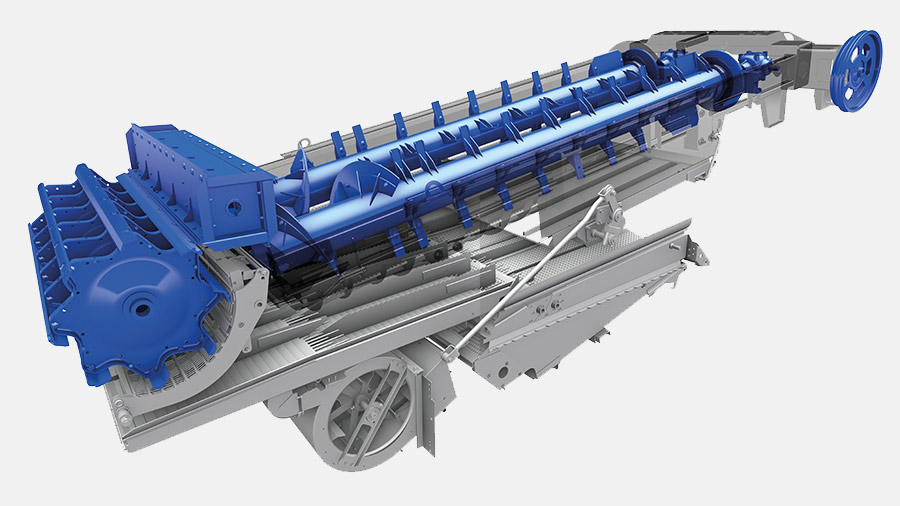
© CNH
Moving to “active” separation rather than the more passive action of straw-walkers means there is less reliance on the up-front elements to thresh every grain from the ear, according to New Holland.
In turn, this means the machine can be set to run more gently, doing away with the need for an additional rotary separator as employed on many walker machines.
As a result, there has been a claimed 35% reduction in cracked grains, while at the same time output has increased by some 25% over an equivalent conventional combine.
(We’re told spot rates of in excess of 40t/hour are possible. Even adjusting that for the pub-chat factor, it’s still pretty impressive).
The simplified driveline makes for a more mechanically straightforward machine that is cheaper to build and run, according to New Holland – good news for potential punters.
That all sounds fantastic, but how has it worked out in the field?
In-field experience
It’s 18 months since New Holland unveiled its hybrid CH combine, and until now there has been little to see of it, the first evaluation machines returning to their Belgian birthplace after field testing in 2020.
However, last harvest one customer received the first production CH7.70 to land on UK shores.
Steve Bushell farms on the edge of the Cambridgeshire Fens, close to March. With a relatively modest acreage to cut (both owned and contracted), he wanted a combine that would be more than capable of comfortably clearing his crops in good time.
“With the CH we’re massively over capacity for our acreage, but that means we only cut corn when it’s dry and when it’s at its best to ensure we meet milling and malting premium spec.”
Farm facts: Steve Bushell, March, Cambridgeshire
- Combined area 175ha
- Cropping Predominantly wheat, barley and sugar beet
- Machinery Tractors – NH T7.270 x2,
Loader – NH LM 7.42
Combine – NH CH7.70 with 8.5m (28ft) Varifeed header
Others 13t Doosan digger and Arjes 250 Impactor crusher - Staff Steve Bushell plus one other part-time worker
Why a New Holland?
“It was a bit of a gamble to sign up for a machine we hadn’t even tried, but it all came down to our dealer – Ernest Doe at Littleport.
Having dealt with them for tractors and kit for our concrete crushing work, I know just how good they are, particularly when it comes to backup.
“I have such faith it them that I took their word that the CH would do the job, and it has – virtually without fault.”
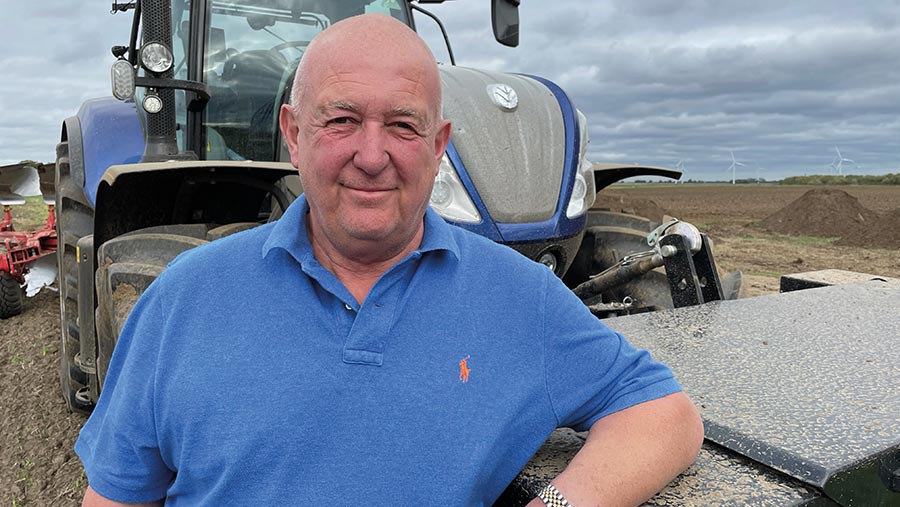
Steve Bushell © Nick Fone
Why a CH7.70?
“I did a fair bit of research and reading on the best options for us and liked the idea of having a drum up front for threshing and then twin rotors to tease out any remaining grain while being gentle on the straw.
“On that front it has proved brilliant. We’ve had comments from our baling contractor about how good the straw is.
“Although you can see in the row where it drops out of the rotors in two distinct lines, it makes for a decent square-shaped swath and the stems are left virtually intact.”
How has it performed?
“This season was bad for shallow-rooted cereals pulling up and bulldozing, so we didn’t really get a chance to test it to full capacity. But it’s certainly got all the output we’ll ever need, even in a catchy season.
“With all the soil and lumps getting picked up the CH didn’t seem to mind, swallowing it and throwing it straight out the back. If it did start to bung up it was just a case of putting it in reverse and letting it spit it back out.
“In terms of power, you never hear the engine note drop or start to grumble, whether chopping or swathing. The crop flow seems really smooth and we’re managing to go for two full days between filling up with fuel.”
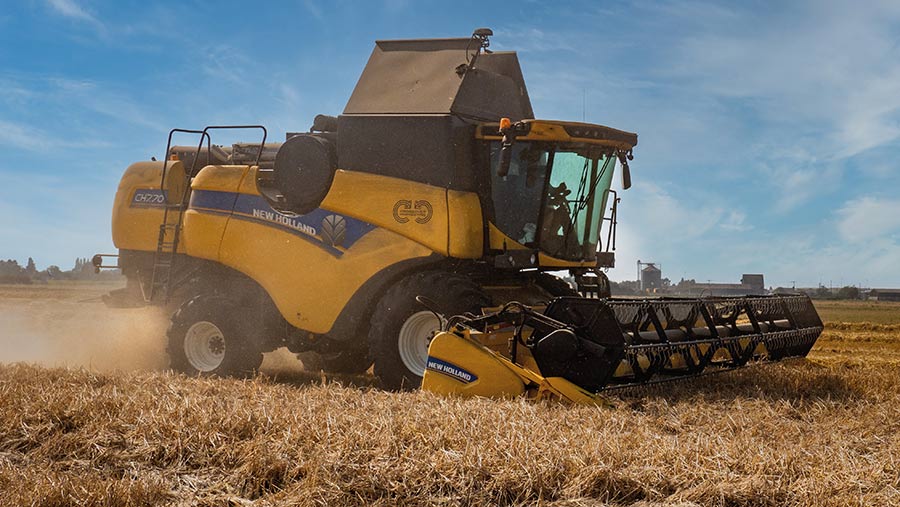
© James de Havilland
What is it like to set up?
“The best thing about the CH is its simplicity. You just select the crop you’re going into on the touchscreen and let the machine decide what settings are best for itself, occasionally tweaking things as conditions change through the day.
“The GPS steering is a godsend and super easy to get to grips with, even for a first-time farmer like me.”
What about maintenance?
“Someone has clearly put a bit of thought into making daily servicing easy. The engine bay has platforms to get all the way around and is clear and uncluttered, so you don’t get dust building up. The labelling of all the grease nipples is good and most only need a shot every 50 hours.”
Has it been reliable?
“We’ve only had a couple of minor niggles so far. At 7pm one evening the combine developed an oil leak on a valve block. Within 40 minutes we had a fitter in the field to look at it and by 8am the following morning it was sorted.
“The other issue was down to the GPS steering. The electric motor failed, but was immediately replaced without quibble under warranty.”
What would you change?
“I’m only 5ft 8in, but even so I have to have the seat rammed against the back of the cab. I’d like a bit more room so that I can recline.
“Also, the chopper drive belts are manually engaged, which is fine, but I feel that on a modern machine this could be done from the cab to avoid getting covered in dust.”
Likes and gripes
✅ Simple combine and GPS setup via touchscreen
✅ Four-wheel-steer header trailer faithfully follows tractor
✅ Worklight package gives full all-round coverage to a decent distance
❌ Limited seat travel
❌ Fiddly manual chopper engagement

